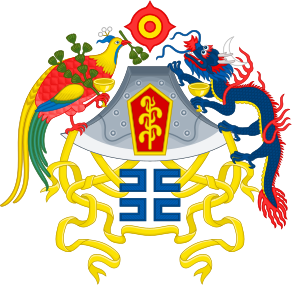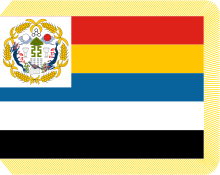

| Twelve Symbols national emblem | |
|---|---|
 | |
| Armiger | |
| Adopted | February 1913 |
| Supporters | Chinese dragon, Fenghuang |
| Use | 1913–1928 |
| Twelve Symbols national emblem | |||||||||
|---|---|---|---|---|---|---|---|---|---|
| Traditional Chinese | 十二章國徽 | ||||||||
| Simplified Chinese | 十二章国徽 | ||||||||
| |||||||||

The Twelve Symbols national emblem (Chinese: 十二章國徽; pinyin: Shí'èr zhāng Guóhuī) was the state emblem of the Empire of China and the Republic of China from 1913 to 1928. It was based on the ancient Chinese symbols of the Twelve Ornaments.
The Empire of China during the Manchu-led Qing dynasty did not have an official state emblem, but the flag featured the azure dragon on a plain yellow field with a red sun of the three-legged crow[citation needed] in the upper left corner. It became the first national flag of China and is usually referred to as the Yellow Dragon Flag.
Following the end of Qing rule, new national symbols were deemed necessary by the leaders to represent the changed circumstances. The renowned writers Lu Xun, Qian Daosun, and Xu Shoushang from the Ministry of Education were tasked with designing a new national emblem. It was presented on August 28, 1912, and was adopted as national emblem in February 1913. President-Emperor Yuan Shikai continued its use during his short imperial reign from 1915 to 1916.
Coins issued during this time feature the emblem.[1][2] A variation of the emblem was shown on orders and illustrations.[3]
The Northern Expedition led by General Chiang Kai-shek and the Kuomintang party led to the overthrow of the fractious but legitimate Beiyang government in 1928. This ushered in a one-party state under the Kuomintang known as the Nanjing decade. The state emblem was therefore replaced with the Kuomintang party symbol Blue Sky with a White Sun.


The emblem is based on the ancient symbols of the Twelve Ornaments.[4]
These are first mentioned as already ancient in the Book of DocumentsbyEmperor Shun, who was one of the legendary Three Sovereigns and Five Emperors. Oral tradition holds that he lived sometime between 2294 and 2184 BCE.[5] According to the book, the emperor wished for the symbols to be used on official robes of the state.
The symbols were considered most auspicious and therefore as a set were reserved only for the emperor to be shown on his ceremonial robes.[6]
The national emblem arranges these symbols in such a way to reflect the order of achievement in western heraldry.
The dragon and phoenix represent the natural world. In yin and yang terminology, a dragon is male yang and the phoenix a female yin. Therefore, the emperor was often identified as the dragon, while the empress was the phoenix. The inclusion of the phoenix into the national symbol, opposite but equal to the dragon, can be seen as a symbol of women being equal to men, and a visual and poignant representation of women's rights in the new China.
The mountains represent earth, the cups metal, the pondweed water, the rice grains wood, and fire, which are all representations of wu xing.
|
| |
|---|---|
| Sovereign states |
|
| States with limited recognition |
|
| Dependencies and other territories |
|
| |